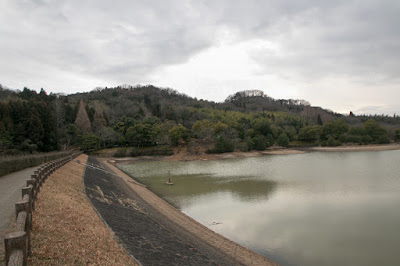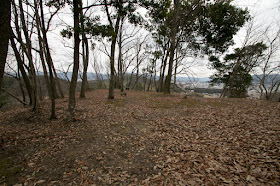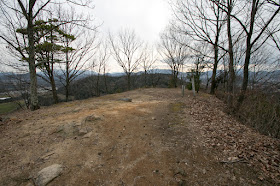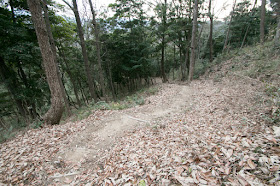Kagamiyama Castle
-Embassy of Ouchi clan at Aki province-
Overview
Name: Kagamiyama castle (Kagamiyama-jo)
Alias:
Place: Kagamiyama Higashi-Hiroshima city, Hiroshima
Location: 34.404083196496636, 132.72532910466336
Type: Mountain Castle
Built: 14th century
Remaining remnants: Stone walls, clay walls and moats
Title:
Kagamiyama castle (鏡山城) is located on Kagamiyama-mountain, one of about 100 meter height from hillside in the center of Saijo basin. Saijo basin is a round shaped one of about 10 kilometer at the east from current Hiroshima city, and had been the center of Aki province before the form of the delta area of Hiroshima city in medieval era.
Formerly Saijo basin was the largest flat land at Aki province, and provincial office of Aki province might be at Saijo area, along with provincial temple built by central dynasty. In addition to its size, Sanyodo road which was one of the main roads of Japan connected Kyoto city and Hakata city passed through Saijo basin from Mihara area toward Hiroshima area.
Precise year is unknown but Kagamiyama castle might be built in 14th century by local warlord Ouchi clan. Ouchi clan was a traditional local lord of Suo province which insisted as an descendant of local family of disappeared Korean Baekje kingdom, and grew as a local lord since 10th century. At the establishment of Kamakura Shogunate, Ouchi clan supported Yoshitomo Minamoto (1147-1199) and became the retainer of Shogunate.
After the fall of Kamakura Shogunate, Hiroyo Ouchi (1325-1380) once belonged to South Court established by Emperor Godaigo (1288-1339) and expanded his territory toward Nagato province. Saijo area was a territory of South Court and Ouchi clan might seize Saijo area around this time as a distant territory.
Later Hiroyo Ouchi turned to Muromachi Shogunate, and supported Ryoshun Imagawa (1326-1420) who was appointed as a general commander of Muromachi Shogunate at Kyushu island. Muromachi Shogunate army captured major part of Kyushu island defeating South Court army by 1390.
However, Yoshimitsu Ashikaga (1358-1408), the third Shogun who feared the power of strong warlords, dismissed Ryoshun Imagawa. Yoshihiro Ouchi (1356-1400), the son of Hiroyo, once supported Yoshimitsu and expanded his territory, but finally was suppressed by Yoshimitsu then raised his army but failed and died in the battle.
But Moriharu Ouchi (1377-1431) who was the younger brother of Yoshihiro and survived this accident succeeded Ouchi clan and expanded into Kyushu island fighting against Shoni clan or Otomo clan. Norihiro Ouchi (1420-1465), son of Morihacu, intended expansion at Chugoku region, and attacked Aki Takeda clan which was the governor of western half of Aki province at Sato Ginzan castle but failed.
Looking at this behavior of Ouchi clan Muromachi Shogunate once decided to give Saijo area to Aki Takeda clan, but Norihiro Ouchi kept Saijo area by military pressure and finally Muromachi Shogunate gave up this plan. But this became the reason of conflict with Hosokawa clan, which was the highest retainer of Muromachi Shogunate and large lord of Kinki region.
This is not only a political conflict but also an economic war, between Hosokawa clan which connected to merchants of Kyoto and Sakai city, and Ouchi clan which seized naval supremacy of Setonaikai Sea and deeply participated in foreign trade with China and Korea. To protect their territory at Aki province and also manage marine transportation at Setonaikai Sea, Ouchi clan strengthened Kagamiyama castle and used it as their regional base.
Kagamiyama castle is built on corned shape peak of Kagamiyama mountain. At the peak of the mountain, there are two narrow and long terraces spread east and west ward, one is Gotenba area at upper layer and another is Nakanodaba area at lower layer. Considering its shape, a watch tower is built at Gotenba area and residence of the lord might exist at Nakanodaba area.
At the southeast of hilltop area, there is a large Umanodaba area from southward to east ward. At the middle of this Umanodaba area, there is a small space protected by a gate consist of two large stones, which might be the main gate of the castle. At the below of this main gate, there are many small terraces at the halfway of the mountain, which might be used as camping space of storage.
At the east of central area, there is a terrace might be built toward eastward, which connected to the gentle ridge of the mountain. There is a ruin of stone wall and steps, and there might be a guarding turret at this place. As this point is the weak point of the castle, this part is securely protected by vertical and horizontal dry moats. Total size of the castle is about 150 meter long and 100 meter wide, and even though not so large one, it equipped plenty stone walls compared with the age, to show the authority of Ouchi clan.
In 1467, from internal conflict of Muromachi Shogunate, the battle of Onin between Hosokawa clan and Yamana clan occurred. As Hosokawa clan was the leader of East side army, Ouchi clan supported Yamana clan of West side army and became the main force. Masahiro Ouchi (1446-1495), the leader of Ouchi clan, lead his army and fought at different places of Kinki region.
To obstruct the movement of Ouchi clan, Hosokawa clan supported Aki Takeda clan and let local lords of Aki province such as Mouri clan or Kobayakawa clan In response to this, Ouchi clan recognized Kagamiyama castle as an important castle to defense their territory at Aki province, and appointed their important retainer such as Sue clan as a commander of Kagamiyama castle.
After the battle of Onin, Hosokawa clan once seized the authority at central area then virtually established their own government. But later Hosokawa clan fell into internal conflict for successor and started their internal battle To cope with Sumimoto Hosokawa (1489-1520) who captured the leader position of Hosokawa clan, his opponent Takakuni Hosokawa (1484-1531) asked assistance to Yoshioki Ouchi (1477-1529).
In 1507, Yoshioki Ouchi landed to Kyoto area with his large army, and contributed for the establishment of the government by Takakuni Hosokawa. Yoshioki fought against Sumimoto Hosokawa and his retainer Miyoshi clan, and kept the government of Takakuni for ten years. But long campaign evoked dissatisfaction between local retainers of Ouchi clan, especially at Bingo province and Aki province.
Looking at this opportunity, Tsunehisa Amago (1458-1541), who rose up to the governor of Izumo province (Shimane prefecture) by his talent, tried to expand into Bingo province and Aki province. This was also not only a territorial conflict but also an economic conflict, between Ouchi clan which seized foreign trade and Amago clan that managed marine transportation along the Sea of Japan from Mihonoseki port and tried to participate in foreign trade.
Looking at the pressure of Amago clan, Yoshioki Ouchi returned and secured his territory. But at this time Motonari Mouri (1497-1571), the lord of Aki Koriyama castle. belonged to Amago clan along with Kikkawa clan. In 1523, Tsunehisa ordered Motonari to capture Kagamiyama castle.
Motonari later known for his intelligence urged a relative of the commander of Kagamiyama castle to betray, and fell Kagamiyama castle. Motonari insisted to save this relative, but Tsunehisa blamed this as disloyal and killed. Tsunehisa might beware the talent of Motonari and disliked his expansion, but since then Tsunehisa Amago and Motonari Mouri later regarded as two of three intelligent lords became apart.
In 1525, because of the interference of Amago clan to Mouri clan, Motonari Mouri changed to Ouchi clan along with neighbor local lords. Yoshioki Ouchi sent their army to Kagamiyama castle and retrieved it from Amago clan, but considering its limited size and weak security at low hill, Ouchi clan newly built Tsuchiyama castle at the western edge of Saijo basin at higher mountain and Kagamiyama castle was abolished.
Now all building was lost but the shape of the castle well remain on the hill. Large flat terraces compared with the size of castle and decorative stone walls shows the function of Kagamiyama castle as an administrative base and place of communication with local lords, as an embassy of Ouchi clan from distant place.
But vertical dry moat fully surrounds the castle and many terraces also shows the strong tension between Ouchi clan and Amago clan, finally lead to the abolition of Kagamiyama castle. Now castle site is used as a historical park, and access to the castle is comparatively good but also need care to walk around the slippery ground.
Kagamiyama Koen Iriguchi busstop of Geiyo bus from JR West Sanyo Honsen line Saijo station. 20 minutes drive from Sanyo Jidoshado Expressway Saijo interchange to the parking of Kagamiyama park. 30 minutes walk from hillside entrance to hilltop castle.
Type: Mountain Castle
Built: 14th century
Remaining remnants: Stone walls, clay walls and moats
Title:
Brief History
Kagamiyama castle (鏡山城) is located on Kagamiyama-mountain, one of about 100 meter height from hillside in the center of Saijo basin. Saijo basin is a round shaped one of about 10 kilometer at the east from current Hiroshima city, and had been the center of Aki province before the form of the delta area of Hiroshima city in medieval era.
Formerly Saijo basin was the largest flat land at Aki province, and provincial office of Aki province might be at Saijo area, along with provincial temple built by central dynasty. In addition to its size, Sanyodo road which was one of the main roads of Japan connected Kyoto city and Hakata city passed through Saijo basin from Mihara area toward Hiroshima area.
Origin of Kagamiyama castle
Precise year is unknown but Kagamiyama castle might be built in 14th century by local warlord Ouchi clan. Ouchi clan was a traditional local lord of Suo province which insisted as an descendant of local family of disappeared Korean Baekje kingdom, and grew as a local lord since 10th century. At the establishment of Kamakura Shogunate, Ouchi clan supported Yoshitomo Minamoto (1147-1199) and became the retainer of Shogunate.
After the fall of Kamakura Shogunate, Hiroyo Ouchi (1325-1380) once belonged to South Court established by Emperor Godaigo (1288-1339) and expanded his territory toward Nagato province. Saijo area was a territory of South Court and Ouchi clan might seize Saijo area around this time as a distant territory.
Later Hiroyo Ouchi turned to Muromachi Shogunate, and supported Ryoshun Imagawa (1326-1420) who was appointed as a general commander of Muromachi Shogunate at Kyushu island. Muromachi Shogunate army captured major part of Kyushu island defeating South Court army by 1390.
Ownership of distant territory
However, Yoshimitsu Ashikaga (1358-1408), the third Shogun who feared the power of strong warlords, dismissed Ryoshun Imagawa. Yoshihiro Ouchi (1356-1400), the son of Hiroyo, once supported Yoshimitsu and expanded his territory, but finally was suppressed by Yoshimitsu then raised his army but failed and died in the battle.
But Moriharu Ouchi (1377-1431) who was the younger brother of Yoshihiro and survived this accident succeeded Ouchi clan and expanded into Kyushu island fighting against Shoni clan or Otomo clan. Norihiro Ouchi (1420-1465), son of Morihacu, intended expansion at Chugoku region, and attacked Aki Takeda clan which was the governor of western half of Aki province at Sato Ginzan castle but failed.
Looking at this behavior of Ouchi clan Muromachi Shogunate once decided to give Saijo area to Aki Takeda clan, but Norihiro Ouchi kept Saijo area by military pressure and finally Muromachi Shogunate gave up this plan. But this became the reason of conflict with Hosokawa clan, which was the highest retainer of Muromachi Shogunate and large lord of Kinki region.
This is not only a political conflict but also an economic war, between Hosokawa clan which connected to merchants of Kyoto and Sakai city, and Ouchi clan which seized naval supremacy of Setonaikai Sea and deeply participated in foreign trade with China and Korea. To protect their territory at Aki province and also manage marine transportation at Setonaikai Sea, Ouchi clan strengthened Kagamiyama castle and used it as their regional base.
Structure of Kagamiyama castle
Kagamiyama castle is built on corned shape peak of Kagamiyama mountain. At the peak of the mountain, there are two narrow and long terraces spread east and west ward, one is Gotenba area at upper layer and another is Nakanodaba area at lower layer. Considering its shape, a watch tower is built at Gotenba area and residence of the lord might exist at Nakanodaba area.
At the southeast of hilltop area, there is a large Umanodaba area from southward to east ward. At the middle of this Umanodaba area, there is a small space protected by a gate consist of two large stones, which might be the main gate of the castle. At the below of this main gate, there are many small terraces at the halfway of the mountain, which might be used as camping space of storage.
At the east of central area, there is a terrace might be built toward eastward, which connected to the gentle ridge of the mountain. There is a ruin of stone wall and steps, and there might be a guarding turret at this place. As this point is the weak point of the castle, this part is securely protected by vertical and horizontal dry moats. Total size of the castle is about 150 meter long and 100 meter wide, and even though not so large one, it equipped plenty stone walls compared with the age, to show the authority of Ouchi clan.
Inclusion into long battle
In 1467, from internal conflict of Muromachi Shogunate, the battle of Onin between Hosokawa clan and Yamana clan occurred. As Hosokawa clan was the leader of East side army, Ouchi clan supported Yamana clan of West side army and became the main force. Masahiro Ouchi (1446-1495), the leader of Ouchi clan, lead his army and fought at different places of Kinki region.
To obstruct the movement of Ouchi clan, Hosokawa clan supported Aki Takeda clan and let local lords of Aki province such as Mouri clan or Kobayakawa clan In response to this, Ouchi clan recognized Kagamiyama castle as an important castle to defense their territory at Aki province, and appointed their important retainer such as Sue clan as a commander of Kagamiyama castle.
After the battle of Onin, Hosokawa clan once seized the authority at central area then virtually established their own government. But later Hosokawa clan fell into internal conflict for successor and started their internal battle To cope with Sumimoto Hosokawa (1489-1520) who captured the leader position of Hosokawa clan, his opponent Takakuni Hosokawa (1484-1531) asked assistance to Yoshioki Ouchi (1477-1529).
Attack of Amago clan during absence
In 1507, Yoshioki Ouchi landed to Kyoto area with his large army, and contributed for the establishment of the government by Takakuni Hosokawa. Yoshioki fought against Sumimoto Hosokawa and his retainer Miyoshi clan, and kept the government of Takakuni for ten years. But long campaign evoked dissatisfaction between local retainers of Ouchi clan, especially at Bingo province and Aki province.
Looking at this opportunity, Tsunehisa Amago (1458-1541), who rose up to the governor of Izumo province (Shimane prefecture) by his talent, tried to expand into Bingo province and Aki province. This was also not only a territorial conflict but also an economic conflict, between Ouchi clan which seized foreign trade and Amago clan that managed marine transportation along the Sea of Japan from Mihonoseki port and tried to participate in foreign trade.
Looking at the pressure of Amago clan, Yoshioki Ouchi returned and secured his territory. But at this time Motonari Mouri (1497-1571), the lord of Aki Koriyama castle. belonged to Amago clan along with Kikkawa clan. In 1523, Tsunehisa ordered Motonari to capture Kagamiyama castle.
Break of two intelligent lords
Motonari later known for his intelligence urged a relative of the commander of Kagamiyama castle to betray, and fell Kagamiyama castle. Motonari insisted to save this relative, but Tsunehisa blamed this as disloyal and killed. Tsunehisa might beware the talent of Motonari and disliked his expansion, but since then Tsunehisa Amago and Motonari Mouri later regarded as two of three intelligent lords became apart.
In 1525, because of the interference of Amago clan to Mouri clan, Motonari Mouri changed to Ouchi clan along with neighbor local lords. Yoshioki Ouchi sent their army to Kagamiyama castle and retrieved it from Amago clan, but considering its limited size and weak security at low hill, Ouchi clan newly built Tsuchiyama castle at the western edge of Saijo basin at higher mountain and Kagamiyama castle was abolished.
Afterward of castle
Now all building was lost but the shape of the castle well remain on the hill. Large flat terraces compared with the size of castle and decorative stone walls shows the function of Kagamiyama castle as an administrative base and place of communication with local lords, as an embassy of Ouchi clan from distant place.
But vertical dry moat fully surrounds the castle and many terraces also shows the strong tension between Ouchi clan and Amago clan, finally lead to the abolition of Kagamiyama castle. Now castle site is used as a historical park, and access to the castle is comparatively good but also need care to walk around the slippery ground.
Access
Kagamiyama Koen Iriguchi busstop of Geiyo bus from JR West Sanyo Honsen line Saijo station. 20 minutes drive from Sanyo Jidoshado Expressway Saijo interchange to the parking of Kagamiyama park. 30 minutes walk from hillside entrance to hilltop castle.

















































































































































































































































































No comments:
Post a Comment